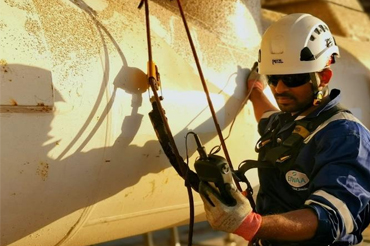ULTRASONIC THICKNESS GAUGING (UTG)
EIWAA Oil and Gas Services offers Ultrasonic Thickness Gauging in Saudi Arabia for corrosion survey and corrosion mapping of piping and pipeline. EIWAA is approved by all major IACS Classification Societies and ports of Saudi Arabia to conduct NDT Inspection and NDT Testing services of ultrasonic thickness gauging inspection.Ultrasonic Thickness Gauging (UTG) is a non-destructive technique for measuring the local thickness of solid material. It is based on the amount of time it takes for an ultrasound wave to travel from under the surface to the depth of the material. In industrial situations, such as mining and shipping industries, UTG is widely used to monitor metal thickness or weld quality.
The vast majority of liquid-filled storage tanks are made of carbon steel plate of S 275 JR or S 355 Material. The use of ultrasonic thickness gauging to measure the thickness of corroded steel plates in Storage tanks and onboard marine structures.. A portion of a steel plate from an oil storage tank that had been failed (as opposed to “passed”) during an ultrasonic thickness gauging inspection was utilized in the measurements. The sections of the plate that were scanned ranged from being “lightly” corroded (with no apparent thickness loss or scaling) to “heavily” corroded (with significant apparent thickness loss and/or scaling). The steel plate’s nominal thickness was 0.25 inches (6.3 mm). The UT Gauging measurements were performed utilizing a dual, annular element, ultrasonic transducer with a 1 MHz center frequency. Pulse-echo measurements were performed at 15 MHz and 5 MHz. Using the ultrasonic thickness gauging services, it was feasible to estimate the thickness of the steel plate practically everywhere, but not with the pulse-echo technique. For pulse-echo measurements, the ultrasonic wavelength was too long to use 1 MHz or 2.25 MHz since echo resolution was not attainable at these lower frequencies. There are few discussions regarding corrosion evaluation/thickness gauging of the state of storage tank nowadays. Although not generally recognized, robotic systems are being created that measure the thickness of the bottom plate using pulse-echo ultrasonics. These do speak to the subject of the present situation. Although the storage tank need not be shut down or empty, it does describe a potential way to calculate the tank bottom/tall wall thickness and consequently, the current condition of a storage tank.

